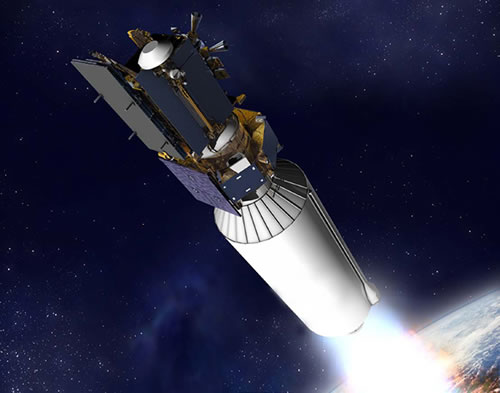NASA changes moon impacting spot based on Chandrayaan Data!!!
 |
An image showing the NASA's LRCOSS and LRO which are meant to find
water on moon( oh - chandrayaan I had found water? then for finding more water  ) They signify NASA's returned ) They signify NASA's returned interest and focus on Moon /Image Credit : NASA |
So after India's almost successful Chandrayaan - I (Indian media dubbed it as a premature failure) , it's the turn of NASA (US) to scrutinize, zoom out , impact, make craters on the moon with it's LRO.
NASA's Lunar Crater Observation and Sensing Satellite mission (LCROSS) based on new analysis of available lunar data, has shifted the target crater from Cabeus A to Cabeus (proper).
NASA has selected the final destination for its Lunar Crater Observation and Sensing Satellite, or LCROSS, after a journey of nearly 5.6 million
miles that included several orbits around Earth and the moon. The mission team announced that Cabeus A will be the target crater for the LCROSS
dual impacts scheduled for Oct. 9, 2009. The crater was selected after an extensive review as the optimal location for LCROSS' evaluation of
whether water ice exists at the lunar south pole.
LCROSS will search for water ice by sending its spent upper-stage Centaur rocket to impact the permanently shadowed polar crater. The satellite will
fly into the plume of dust left by the impact and measure the properties before also colliding with the lunar surface.
"The selection of Cabeus A was a result of a vigorous debate within the lunar science community that included review of the latest data from
Earth-based observatories and our fellow lunar missions Kaguya, Chandrayaan-1, and the Lunar Reconnaissance Orbiter," said Anthony Colaprete,
LCROSS project scientist and principle investigator at NASA’s Ames Research Center in Moffett Field, Calif. "The team is looking forward to
the impacts and the wealth of information this unique mission will produce."
About the Lunar Craters
The LCROSS will impact the moon surface and create a crater. So they are exploding the lunar surface.. amigosh , they are going to spoil the lunar
surface? Ofcourse India also impacted it's Moon Impact Probe (MIP) on the lunar surface. NASA explains how small the crater will be when
compared to craters naturally created on Moon surfaces due to various geological processes.
, they are going to spoil the lunar
surface? Ofcourse India also impacted it's Moon Impact Probe (MIP) on the lunar surface. NASA explains how small the crater will be when
compared to craters naturally created on Moon surfaces due to various geological processes.
This is what NASA got to say of the crater-
When LCROSS’s Centaur upper stage impacts the Moon, it will create an impact crater. This is nothing new, the Moon’s surface is covered
with billions of craters. This process of crater formation has been going on for billions of years, and is still going on today as pieces of rock and
ice continue to crash into the Moon.
Scientists estimate that the crater that will be created by LCROSS’s impactor will be about 20 to 25 meters in diameter, or about 1/3 the size
of a football field. How does this compare to other craters on the Moon?
Through a telescope, one of the most eye-catching of the lunar craters is Copernicus. This beautiful example is 93 kilometers in diameter, bigger than
a large city. Copernicus shows lots of fine detail that helps us understand how such craters form. But as spectacular as Copernicus is, it is far from
the largest impact feature on the Moon.
The largest craters, called impact basins, are big enough to be seen even without a telescope. Look up at the full Moon and se if you can identify
some of these impact basins. The central areas of some like the Iridium Basin and the Crisium Basin show up as dark areas because of ancient lava
flows that flooded their floors. The Crisium Basin is over 600 kilometers in diameter, and the Iridium basin is 1,200 kilometers across.
The largest impact basin is almost entirely on the far side of the Moon. The Aitken Basin is 2,500 kilometers across. Compared to this, the LCROSS
crater sounds tiny, and it is.
If you are more interested (and can understand and digest ) about all these heavenly things - click here to have look at the beautiful animation of Lunar craters on NASA's website.
If you find all this really interesting please leave a feedback , we will more closely follow the Moon ... atlast it's my dream to be there...
